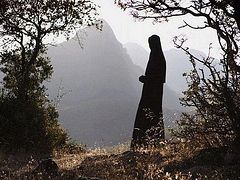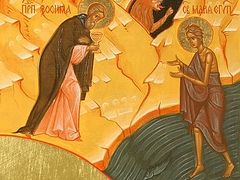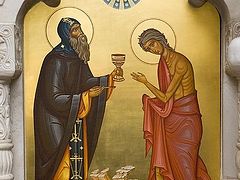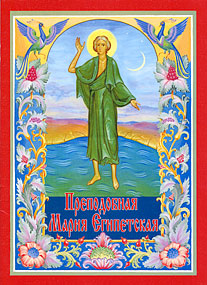 Robert (Roman) Balakshin. Venerable Mother Mary of Egypt. Moscow, Stretensky Monastery, 2005, ISBN 5-7533-0374-9 The nomadic tribe of the Saracens in the fifth century was truly a source of persistent trouble of God for the Christians in Palestine. Out of nowhere, their flying squads would raid villages, looting, burning and killing, and then disappear just as quickly back into the desert, as if they were ghosts, and not men.
Robert (Roman) Balakshin. Venerable Mother Mary of Egypt. Moscow, Stretensky Monastery, 2005, ISBN 5-7533-0374-9 The nomadic tribe of the Saracens in the fifth century was truly a source of persistent trouble of God for the Christians in Palestine. Out of nowhere, their flying squads would raid villages, looting, burning and killing, and then disappear just as quickly back into the desert, as if they were ghosts, and not men.
A watchtower guard of a large village once saw a cloud of dust in the distance. While he stood there wondering what it could be, the cloud grew larger. When the guard saw swords flashing in the dust like tiny lightning bolts, he sounded the alarm, but it was too late. The robbers burst into the village, breaking into the houses, setting their roofs on fire and slashing with their sabers left and right.
Soon, smoldering ashes and the scattered bodies of villagers who had died trying to protect their families were all that was left from a once thriving village.
A little boy named Zosimas was crying on the threshold of one such house. The villains had killed his parents. The neighbors, who were also struggling to make ends meet, couldn’t afford to take in the orphaned boy and so they took him to a monastery. The abbot, a compassionate elder, lovingly took him in, and after some time, tonsured him a monk. Fifty years passed in deeds of prayer. That boy grew to become a gray-haired elder, a strict faster and a man of prayer. People from nearby villages and distant cities flocked to him for spiritual advice.
For many years, the evil spirit tempted the elder with thoughts and temptations in an attempt to divert him from the path of prayer, but was defeated and forced to flee. Whether Zosimas was eating or working at his monastery’s obedience, the Jesus Prayer never went silent inside his heart and he never failed to remain meek and humble.
But the spirit of evil is audacious and cunning, inventing all possible kinds of tricks to sneak deep inside the human soul. It also uses even our smallest mistake to nest inside the human soul.
And so, the spirit didn’t give up on Zosimas and nearly succeeded.
Having completed his monastic prayer rule one night in his cell, Zosimas mused about himself.
“Is there another monk on earth,” he wondered carelessly,
“who is a man of prayer and fasting like me? Can anyone else be found who has surpassed me in monastic exploits?”
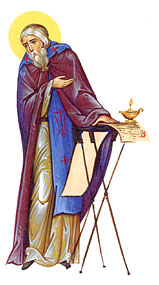 St. Zosimas. Drawing by Anna Kudinova and Daria Shabalina. Printed by Sretensky Monastery, 2005. Without ever realizing it, Zosimas yielded to the sin of pride.
St. Zosimas. Drawing by Anna Kudinova and Daria Shabalina. Printed by Sretensky Monastery, 2005. Without ever realizing it, Zosimas yielded to the sin of pride.
The Lord came to the rescue of His chosen one. Zosimas wasn’t even done with his prideful dreams, when the Angel of the Lord appeared to him.
“Zosimas,” the Angel said to the monk who stood trembling in awe, “you zealously and valiantly labor at your monastic exploits. But there are other struggles, loftier than the ones you have accomplished. Go to the monastery by the River Jordan and there is where you will be convinced of the justice of my words.”
Not daring to disobey the Angel, Zosimas said good-bye to the brethren of his beloved monastery, and after travelling for four days, he finally saw the distant waters of the holy river gleaming ahead. The abbot of the Jordan monastery warmly welcomed the honorable Zosimas, offered him a brightly lit cell, and frequently came to talk to him about the salvation of the soul and the labor of prayer.
There was a remarkable rule in this monastery. On the first week of Great Lent, during the Liturgy, everyone would partake of the Holy Blood and Body of Christ, eat a modest meal and then reassemble in the church. After a lengthy kneeling prayer, they would step outside the monastery gates, each taking only a small supply of bread and water. After crossing the Jordan, they went their separate ways to spend Great Lent in the solitude of the desert. Having returned to the monastery a week before the Resurrection of Christ, no one asked the other about the time they spent in the desert or what the other was doing there.
The elder Zosimas, like the rest of the monks, wandered around in the wilderness, praying and devoting himself to contemplating God.
By the end of the third week of his solitary wanderings, Zosimas grew tired. He had always had a roof over his head at his former monastery, but here there was nothing but the scorching sun during the day, a lion roaring nearby and jackals laughing shrilly at night. Or, sometimes a sandstorm would come on, its wind throwing a dry handful of sand in his face, with his skin as if pierced by a thousand tiny needles. And he’d spend hours lying on the ground, wrapped in a cloak up to the top of your head, waiting until the storm dies down. The wind would whistle and howl above him, and the sand would grind in his teeth.
For want of habit, this feat of prayer appeared difficult for Zosimas. He took to counting the days that remained before his return to the monastery and even thought of returning there before the time. But one incident brought him back to his senses.
To chase away his cowardly thoughts, Zosimas sang the prayers of the Sixth Hour. Suddenly, he shuddered: Another shadow, of yet another human being, became clearly visible beside his own. “It must be a demonic temptation,” the elder thought and redoubled his effort to recite the prayers. But the shadow didn’t go away. Zosimas turned around and moved back reflexively. A human being stood in front of him. Or rather, a creature that looked like a human. His skin was dark brown, almost black, like a burnt cake. Long, shaggy, gray hair covered his chest and shoulders. The man was naked, not a shred of clothing on him. Still, it was a human.
His eyes, lively human eyes, watched Zosimas intently and keenly. Zosimas, who had not seen a single human soul during his many days of wanderings in the desert, joyfully stepped towards this wondrous stranger. But the person swiftly ran further away from him.
“Wait,” shouted Zosimas, “don't run away from me. Stop. Please come closer and tell me: who are you?”
“I cannot come near you,” the stranger replied, "for I am a woman. Throw me some clothes of yours.”
Zosimas threw her his tattered cloak, the woman wrapped herself in it and approached the elder.
“Bless me,” he asked her.
“No, Abba Zosimas,” said the woman, “only you can bless, for you are a priest, not me.”
St. Zosimas couldn’t believe his ears. How did this woman whom he was seeing for the first time know his name and rank? She is surely a clairvoyant and a saint.
“No, holy mother,” Zosimas objected, “it is I who must humbly ask your blessing, for I see that you are a righteous woman and that the grace of God rests on you.”
Yielding to his pleas, the woman blessed Zosimas and asked:
“Tell me, how are Christians and the holy Church living these days?”
“Through the prayers of the saints,” Zosimas replied, “the Church is flourishing and the word of God is freely preached throughout the whole world. Now let us pray to the Lord for the whole world and for all of us sinners.”
The woman turned towards the east and silently said the words of prayer. Zosimas also prayed. But then his knees grew weak and he fell to the sand; the desert-dwelling righteous woman lifted off the ground by as much as a forearm and stood in the air, as if supported by the raised platform.
My Lord, thought horror-stricken Zosimas, but this is a spirit, a ghost, and I was asking for her blessing.
“You shouldn’t feel confused, father,” said the woman as she finished praying and offered her hand to the elder, helping him to his feet. “I am not a ghost. You can see that my hand is like yours, made of flesh and blood.”
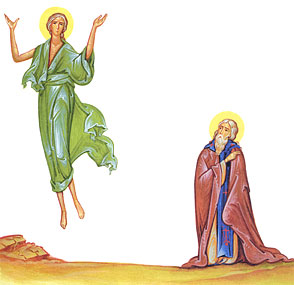 St. Mary’s standing on air. Drawing by Anna Kudinova and Daria Shabalina. Printed by Sretensky Monastery, 2005. Zosimas stood silent for a while, stunned by the vision, and then steadfastly entreated the woman to tell him everything: Who was she, where came from, and how did she up here?
St. Mary’s standing on air. Drawing by Anna Kudinova and Daria Shabalina. Printed by Sretensky Monastery, 2005. Zosimas stood silent for a while, stunned by the vision, and then steadfastly entreated the woman to tell him everything: Who was she, where came from, and how did she up here?
“I will not leave this place until I learn about your life. Believe me, mother, I was proud of my exploits, but they are nothing compared to your feats. Tell me, share your story with me.”
“But what can I tell you?” the woman sighed. “I am a great sinner. I brought forth so much evil into this world and planted so many seeds of vice that even two lives would not be enough to implore God to forgive me for them. No, there is really nothing for me to tell you about.”
Zosimas saw that the woman’s soul was full of true humility and so he continued to plead with her. Finally, the woman agreed.
“It is painful to tell you about the shameful life I led before,” she began. “But I will lay my soul bare before you. When you learn everything about me, don’t despise me but pray that I may obtain mercy on the Last Judgment Day.”
The elder Zosimas was distressed and saddened to hear the plain tale of the desert dweller. How early, it turns out, can sin enslave a person and so entangle him with its tentacles of evil habits that he truly lives in its captivity.
Zosimas, who was sent to the monastery as a small child, didn’t learn many temptations of worldly life, but his new acquaintance had been born in a small village in Egypt and lived there before she came of age. Her parents adored their daughter and dreamed of raising her as a virtuous, honorable woman. From the merchants who passed through their village, the girl learned about the wealthy and beautiful city of Alexandria. It was so large that it was impossible to walk around it even in a week; It was so rich that merchants from all over the world flocked to it, and living there was so easy that anyone, unless he was an absolute fool, could easily find a job to his liking. These words of the merchants sank deep into the young girl’s heart.
“Was this really what I was born for,” she wondered, “that I am I to see my beauty fade away in the backwoods of this boring, godforsaken place? Is it fair that some people are immersed in all the delights that Alexandria has to offer, while I am doomed to languish in obscurity, doing nothing all my life but tending sheep and chickens and weaving wool?” From that time on, all her thoughts have were about Alexandria. In her imagination, the city emerged as a magnificent, fairy-tale-like castle, and she loved to boast to her girlfriends that her name would be known throughout the city.
She turned a deaf ear to the admonitions of her father and mother, startin lashing back and was rude with them, and, then, one night, after she turned twelve years old, she ran away from her home.
Alexandria did turn out to be a magnificent, wealthy, and beautiful city, but it was also completely indifferent to her, a girl from the backcountry. When she became hungry, the girl begged for food, but the pie makers and bakers drove her away from their stalls. In order not to die of hunger, she indulged in vices and soon learned to love this way of life—spending days in slumber, and nights wasting life away and reveling at feasts. Her name did become known all over Alexandria, but not in a glorious way, rather because of her shameful fame as a harlot and a dissolute woman.
“When I turned seventeen,” the ascetic told Zosimas, “I met a crowd of people on the embankment near the famous lighthouse. ‘Where are you going?’ I asked them. ‘To board the ship to Jerusalem for the celebration of the feast of the Exaltation of the Honorable and Lifegiving Cross,’ I was told. So I went with them. During the voyage, I joined a group of rowdy men. With nary a thought of where this ship was going, we carelessly spent our time onboard gorging ourselves on wine and arousing one another with indecent songs. Even after we arrived there, I spent the days preceding the feast of the Exaltation not in prayer or fasting, but in the most sordid revelry.
“On the day of the feast, I nonchalantly joined all the pilgrims as they were walking to the temple, but… I was unable to step over its threshold. I got mad and angry, yet there was as if an invisible barrier that prevented me from entering the temple. Hiding behind the backs of other pilgrims, I hoped to stealthily sneak into the house of prayer, but an invisible wall cut me off from the pilgrim who was walking in front of me.
“Tiring out in vain, I stepped back to the church narthex, and utterly exhausted, I leaned against the wall. Beside me, more and more people were passing through the church gates.
“’What have I come to!’ I said to myself. ‘On the Judgment Day, the wheat will be separated from the chaff to be burned later, but I am already separated, I am already utterly worthless rubbish. I violated the vows of the Holy Baptism, and my sins crucify Christ every day. I am like the dogs that are forbidden from entering the church.’
“An icon of the Mother of God was hung on the narthex wall.
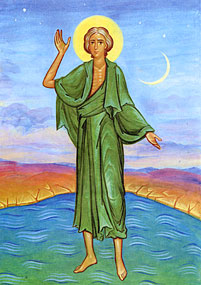 St. Mary of Egypt. Drawing by Anna Kudinova and Daria Shabalina. Printed by Sretensky Monastery, 2005. “’Most Holy Mother of God,’ I prayed, having remembered the time when I was still an innocent and chaste girl. ‘Give the command so that I may enter the temple and venerate the Holy Tree on which Your Son was crucified! I will no longer defile my body with fornication and will go there where You lead me!’
St. Mary of Egypt. Drawing by Anna Kudinova and Daria Shabalina. Printed by Sretensky Monastery, 2005. “’Most Holy Mother of God,’ I prayed, having remembered the time when I was still an innocent and chaste girl. ‘Give the command so that I may enter the temple and venerate the Holy Tree on which Your Son was crucified! I will no longer defile my body with fornication and will go there where You lead me!’
“At that same moment, I felt an extraordinary lightness in my limbs and I was able to step freely inside the temple. When I came closer the Holy Tree, the tears of repentance and contrition flowed plentifully from my eyes.
“As I was leaving the temple, I stopped one more time before the icon of the Mother of God.
“’I thank You, Most Merciful Sovereign Lady,’ I said, ‘for You took pity on me. Now it’s time that You set me on the path of repentance.’
“’Mary,’ I heard a voice coming from the icon, ‘go beyond the Jordan River, there you will find glorious rest.’
“I left the temple. On my way out, someone gave me three copper coins with which I bought three loaves of bread at a nearby street-stand.
“Having arrived to the River Jordan on the following day, I washed myself in its waters, partook of the Holy Mysteries of Christ and withdrew to the desert where I reside to this day. It’s been forty seven years since I left Jerusalem.”
“What food did you have all these years?” asked Zosimas.
“The loaves I bought gradually dried up and became hard as rock, so this was my food for seventeen years, and later I fed on herbs. But more often than not, the word of God was my food, for Man shall not live by bread alone (Matthew 4:4). The clothes I had were reduced to dust, and in the summer, I suffered greatly from extreme heat and from cold in the winter. Many times did I fall to the ground breathless, suffering from extreme torment.
But my spiritual anguish was worse than the pangs of hunger or physical sufferings. My memories of my previous life full of debauchery tormented me so much that I fought with them as if they were fierce beasts. When I was about to partake of a few bits of rock-hard bread, I would be overcome with memories of all the fruits, and meats, and delicacies with which I had satiated my belly. When I came across some water, all my thoughts were about the wine I once drank to my heart's content. These memories were driving me mad. Pictures of my sinful exploits came back to haunt me, and scenes of debauchery appeared before me as vividly as if I saw them live. If I had enjoyed these memories before, this time they pierced my soul like thorn. Again and again I cried out to the Lord seeking His forgiveness, beseeching Him to accept my repentance. But now it is time for us to part ways. Don’t tell anyone about me until the Lord summons me to Himself. We will see one another again next year. Bring with you the Holy Mysteries of Christ. Now depart in peace.”
The holy ascetic bowed down before Zosimas at parting. The elder gazed after her for a long time, then kissed the sand on which she stood, and returned to his monastery.
On the way there, he remembered with shame his former prideful ideas of himself. “You gave yourself airs, you thought heaven knows what and how much of yourself,” Zosimas thought. “But the Lord taught you a lesson and let you meet a humble holy ascetic who didn’t pride herself nor has any regrets that no one in the whole entire world knows about her.”
A year passed as if it were one day. Once again there came the day of the Bright Resurrection of Christ. On Holy and Great Thursday, Zosimas took a small chalice of the Body and Blood and travelled the already known path towards the Jordan.
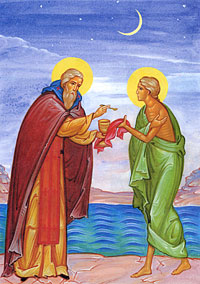 St. Zosimas administers Communion to St. Mary of Egypt. Drawing by Anna Kudinova and Daria Shabalina. Printed by Sretensky Monastery, 2005. Waiting for the holy ascetic to come, Zosimas was looking at the overflowing waters of the Jordan and wondered how she would cross the river. There was neither a boat nor a raft on the bank.
St. Zosimas administers Communion to St. Mary of Egypt. Drawing by Anna Kudinova and Daria Shabalina. Printed by Sretensky Monastery, 2005. Waiting for the holy ascetic to come, Zosimas was looking at the overflowing waters of the Jordan and wondered how she would cross the river. There was neither a boat nor a raft on the bank.
Night had fallen and the bright moon had risen. In its light, Zosimas saw a desert dweller coming to the shore. She made the sign of the cross over the river, stepped onto the moonlit path on the water that spread across the water surface, and crossed the Jordan as if it were an earthen path.
Beholding this miracle, Zosimas, in silent prayer, exultantly thanked the Lord Who showed him once again how far he was from perfection.
The holy desert dweller asked Zosimas to recite the Creed, and after she partook of the Holy Mysteries of Christ, she tearfully exclaimed:
“Now lettest Thou Thy servant depart in peace, O Master, according to Thy word; for mine eyes have seen Thy salvation…”
“Father,” the holy woman said to Zosimas, “grant yet another request of mine. Go right away to your monastery, but next year come again so that you may see me again, for this is the will of God.”
“How I wish,” said the elder sighing, “to see you not once in a year, but every day! To see and hear the words that the Holy Spirit truly inspires you to say.”
Another year passed. Zosimas hastily traversed the desert—so eager he was to soon see the holy God-pleasing saint. Here was the stream where they had had their conversation. From afar, he noticed a body lying on the sand. It was the desert dweller. The hands of the deceased were crossed on her chest, her eyes were closed, but her face was light and also beautiful, with that kind of beauty the Lord bestows only upon His saints. Zosimas kissed the saint’s feet and wet them with his tears.
On the ground by her head, the elder saw a sign that read: “Bury on this spot, Abba Zosimas, the body of humble Mary.”
That’s how Venerable Mary of Egypt, the great saint of the Orthodox Church, completed her earthly sojourn.
With tears and prayers, the elder buried her and returned to the monastery. That’s when he shared with brethren the story of her exploits.
We can see that based on the life of the Venerable Mother Mary, there is no sin that can’t be redeemed by sincere repentance. If we succeed at overcoming our vices, we will just as surely please God with this spiritual feat, like the Holy Mary of Egypt had pleased Him.

